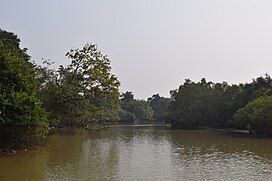| Bhitarkanika Mangroves | |
|---|---|
 | |
| Ecology | |
| Realm | Indomalayan realm |
| Animals | saltwater crocodile, olive ridley turtle |
| Geography | |
| Area | 650 km (250 sq mi) |
| Country | India |
| State | Odisha |
| Coordinates | 20°43′51″N 86°51′59″E / 20.730696°N 86.866511°E / 20.730696; 86.866511 |
| Oceans or seas | Bay of Bengal |
| Rivers | Brahmani River |
| Climate type | Am |
| Ramsar Wetland | |
| Designated | 19 August 2002 |
| Reference no. | 1205 |
Bhitarkanika Mangroves is a mangrove wetland in Odisha, India, covering an area of 650 km (400 mi) in the Brahmani River and Baitarani River deltas.
History
The Bhitarkanika Mangroves were zamindari forests until 1952, when the government of Odisha abolished the zamindari system, and put the zamindari forests in the control of the state forest department. In 1975, an area of 672 km (259 sq mi) was declared the Bhitarkanika Wildlife Sanctuary. The core area of the sanctuary, with an area of 145 km (56 sq mi), was declared Bhitarkanika National Park in September 1998. The Gahirmatha Marine Wildlife Sanctuary, which bounds the Bhitarkanika Wildlife Sanctuary to the east, was created in September 1997, and encompasses Gahirmatha Beach and an adjacent portion of the Bay of Bengal. Bhitarkanika Mangroves were designated a Ramsar Wetland of International Importance in 2002.
Flora and fauna

About 62 mangrove species occur in the Bhitarkanika Mangroves, including Avicenna, Bruguiera, Heritiera and Rhizophora. Reptiles present in the mangroves include saltwater crocodile, king cobra, Indian python and water monitor. Between August 2004 and December 2006, 263 bird species were recorded, encompassing 147 resident and 99 migrant species. A heronry encloses about 4 ha (9.9 acres), where 11,287 nests were counted in 2006.
Olive ridley turtles arrive in January to March for nesting at Gahirmatha Beach. An average of 240,000 nests per season was estimated between 1976 and 1996. Up to 80,000 turtles were captured every year until 1982. Since 1983, collecting and marketing turtles and their eggs has been banned.
See also
References
- "Bhitarkanika Mangroves". Protected Planet. Archived from the original on 2019-09-25. Retrieved 2019-09-25.
- "Bhitarkanika Mangroves". Ramsar Sites Information Service. Archived from the original on 9 May 2018. Retrieved 25 April 2018.
- "Ramsar Convention Official site". Archived from the original on 2013-12-12.
- Gopi, G. V.; Pandav, B. (2007). "Avifauna of Bhitarkanika mangroves, India". Zoos' Print Journal. 22 (10): 2839–2847. doi:10.11609/JoTT.ZPJ.1716.2839-47.
- Rajagopalan, M.; Vivekanandan, E.; Pillai, S. K.; Srinath, M.; Bastian, F. (1996). "Incidental catch of sea turtles in India" (PDF). Marine Fisheries Information Service. Technical and Extension Series (143): 8–17. Archived (PDF) from the original on 2018-11-02. Retrieved 2019-05-19.
External links
- Bhitarkanika.org Archived 2021-04-11 at the Wayback Machine
- Mangroves of Orissa (Orissa State Forest Department: Wildlife Organisation)
- Bhitarkanika Trip report - Wildlife Times
- Bhitarakanika : Tourists Place in Odisha
- YouTube Video
| Protected areas of Odisha | |
|---|---|
| Biosphere reserves | |
| National parks | |
| Wildlife sanctuaries | |
| Bird sanctuaries | |
| Zoos | |
| Protected areas of India | |